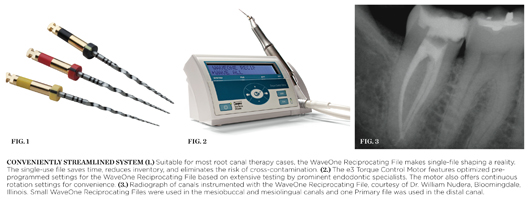WaveOne® Reciprocating File
Single-file shaping streamlines procedures and inventories while eliminating cross-contamination.
From DENTSPLY Tulsa Dental Specialties, the WaveOne® Reciprocating File provides a breakthrough approach to endodontics with a single-file shaping technique. This technique streamlines procedures by reducing the time spent organizing and changing instruments during root canal therapy. This optimizes efficiency for clinicians and decreases total shaping time by up to 40% versus a traditional continuous-motion rotary technique (data on file, DENTSPLY Tulsa; www.waveonefile.com). Although the WaveOne Reciprocating File is available in three sizes (Figure 1), only one is required per root canal in most cases. The file features M-Wire® nickel-titanium (NiTi) construction for increased flexibility and greater resistance to cyclic fatigue compared to conventional NiTi), the leading cause of file separation.1
Patented Reciprocation and the e3™ Torque Control Motor
The reciprocating motion of the WaveOne Reciprocating File is different from traditional, continuously rotating files—as well as from other reciprocating files that employ equal back-and-forth motions. The WaveOne Reciprocating File uses a patented motion with a larger rotating angle in the cutting direction, and a smaller angle in the opposite direction. Typically, NiTi files have an elastic limit of 1.5 to 2 rotations before failure. The WaveOne Reciprocating File is designed to rotate more in one direction and less in the other, which employs the “mechanical balanced forces” technique that allows the file to remain below the elastic limit of traditional NiTi files. Moreover, this motion helps the WaveOne Reciprocating File successfully track the natural canal path without locking into the canal.
The e3 Torque Control Motor from DENTSPLY Tulsa Dental Specialties makes this proprietary motion possible (Figure 2). Its pre-programmed settings are optimized with fixed speed and angle parameters for the WaveOne Reciprocating File. For convenience, the e3 Torque Control Motor is also pre-programmed with continuous rotation settings for several popular NiTi rotary systems as well as the Gates-Glidden drills. It also provides 15 Doctor’s Choice programmable settings in the continuous rotation mode. The motor is rechargeable-battery operated and includes a 6:1 reducing handpiece.
Pre-Sterilized for Single Use
In addition to providing single-file shaping, the WaveOne Reciprocating File offers pre-sterilized, single-use convenience. Regardless of how well an instrument is sterilized, research shows that some tissue and bacteria may still be present. Clinicians can feel confident knowing that the single-use WaveOne option eliminates the risk of cross-contamination. Because there is no need for sterilizing, the single-use WaveOne Reciprocating File saves time, as well. In addition, clinicians can always count on optimal cutting efficiency from the single-use WaveOne Reciprocating File because a new instrument is used for each patient.
Predictable Shapes and System-Based Convenience
With its streamlined, single-file technique, the WaveOne Reciprocating File saves time, reduces inventory requirements, and prevents cross-contamination. However, the true measure of any file system and technique is seen in its ability to enhance clinical outcomes. The WaveOne Reciprocating File is designed to predictably shape the root canal completely from start to finish—while maintaining canal wall integrity and retaining tooth structure (Figure 3). In addition, the WaveOne Reciprocating File is part of a complete endodontic system designed to increase efficiency and clinical success. WaveOne paper points, gutta-percha points, and obturators are available to match the size of the canals prepared with the WaveOne Reciprocating File. A WaveOne obturator oven rounds out the system-based efficiency by heating WaveOne obturators in 20 to 49 seconds, depending on the obturator size.
Reference
1. Shen Y, Cheung GS, Bian Z, Peng B. comparison of defects in Profile and Protaper systems after clinical use. J Endod. 2006;32(1):61-65.
For more information, contact:
DENTSPLY Tulsa Dental Specialties
Phone: 800-662-1202
Web: www.tulsadentalspecialties.com
Disclaimer
The preceding material was provided by the manufacturer. The statements and opinions contained therein are solely those of the manufacturer and not of the editors, publisher, or the Editorial Board of Inside Dentistry.







